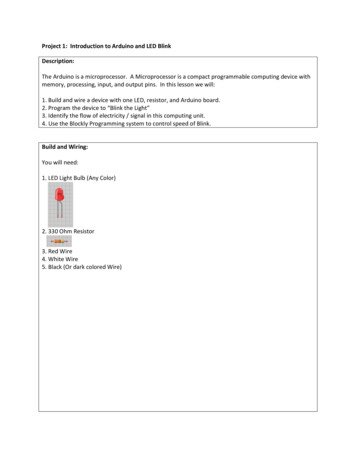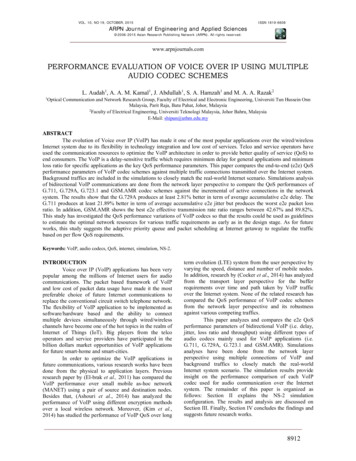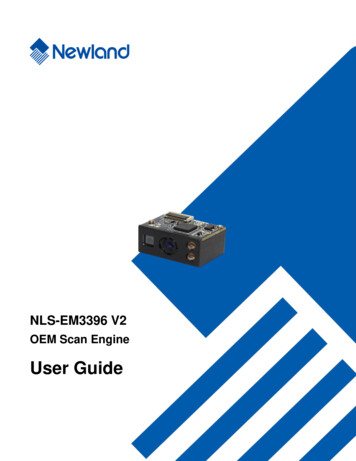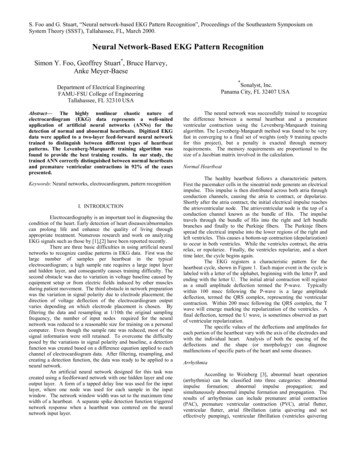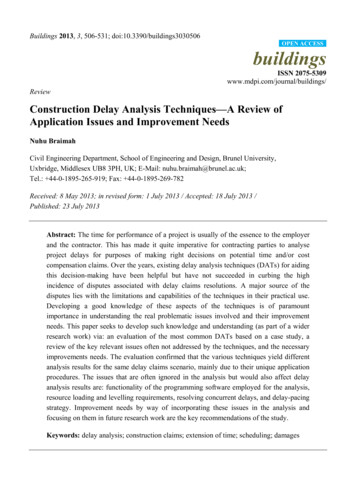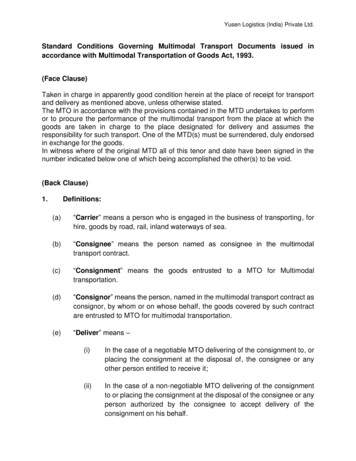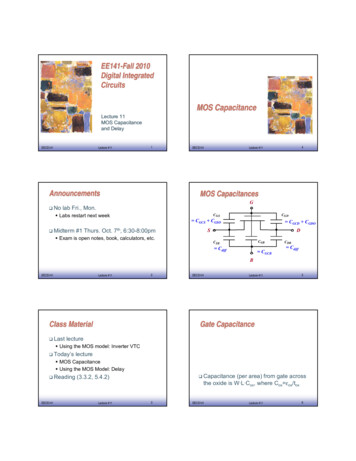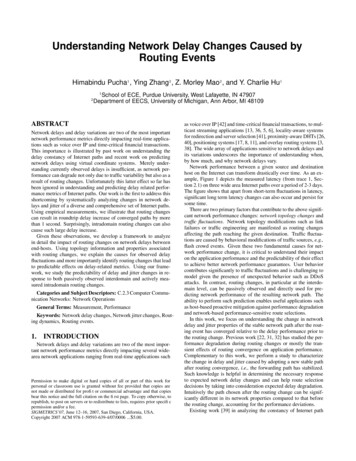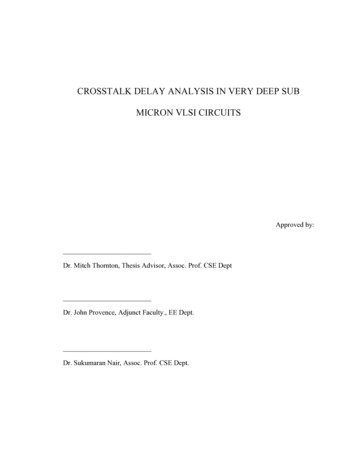
Transcription
CROSSTALK DELAY ANALYSIS IN VERY DEEP SUBMICRON VLSI CIRCUITSApproved by:Dr. Mitch Thornton, Thesis Advisor, Assoc. Prof. CSE DeptDr. John Provence, Adjunct Faculty., EE Dept.Dr. Sukumaran Nair, Assoc. Prof. CSE Dept.
CROSSTALK DELAY ANALYSIS IN VERY DEEP SUB MICRON VLSI CIRCUITSA Thesis Presented to the Graduate Faculty ofSchool of EngineeringSouthern Methodist UniversityinPartial Fulfillment of the Requirementsfor the degree ofMaster of ScienceWith aMajor in Computer EngineeringbySatyendra Ravi Prasad Raju Datla(Bachelor of Engineering, I.E.T.E, New Delhi)May 15th 2004
ACKNOWLEDGEMENTSThe author wants to take the opportunity to thank all the people that supported thisproject. In particular, I owe a great deal of gratitude to my advisor Professor MitchThornton, who encouraged me all throughout this project and also helped me organize thework. My special thanks to Professor Sukumaran Nair and Professor John Provence forreadily agreeing to be on the thesis committee and providing useful suggestions duringthe project work. I here by thank all the friends and staff at CSE Dept for helping meduring the project and providing help during the thesis writing.I also thank my mother for her unwavering support during the many long days, whichwent into this endeavor. I am also grateful to all my family members and well-wisherswhose love and caring for me always inspired me.iii
Datla, SatyendraBachelor of Engineering,I.E.T.E., New Delhi, 1999CROSSTALK DELAY ANALYSIS IN VERY DEEP SUB MICRON VLSI CIRCUITSAdvisor: Professor Mitch ThorntonMaster of Science conferred May 15th, 2004Thesis completed month , date , 2004AbstractIntegrated Circuit design has seen revolutionary progress in the past quarter century.Explosive growth of semiconductor applications has happened as a result of severaltechnological breakthroughs. IC design community today embracing sub-100nm waferdesign technologies, known as very deep sub-micron (VDSM) technologies, to takeadvantage of the superior integration possibilities. At these technologies, manyphenomena affect gate and wire delays. Capacitive coupling between neighboring wiresis one such phenomena that is having significant effect on design’s timing andfunctionality goals. The accurate estimation of these effects is a ‘must have’ requirementfor any design that gets manufactured using the VDSM technologies.iv
This thesis summarizes the study conducted to identify the root causes of thecrosstalk due to capacitive coupling. A case study is conducted on a complex VLSIdesign to check on the possible effects of the crosstalk on its timing and functionalitygoals. An efficient analysis and fixing flow is developed and its effectiveness iscompared with other available approaches. Some methods are proposed to address thecrosstalk problem ahead in the design flow.v
TABLE OF CONTENTSLIST OF FIGURES . .xLIST OF TABLES. . .xiiCHAPTERS1 THESIS OVERVIEW . 12 INTRODUCTION . 52.1 What is signal integrity . 72.2 Signal Integrity issues . 72.3 Aggressor versus Victim:. 82.4 Inductive crosstalk vs. Electro-static crosstalk . 83 CROSSTALK EFFECTS IN VDSM DESIGNS . 133.1 Timing effect of Crosstalk Delay Violations . 153.1.1 Hold violations. 15vi
3.1.2 Setup violations. 173.1.3 Bus violations . 184 DESIGN DETAILS. 205 CROSSTALK ANALYSIS METHODOLOGY . 225.1 Coupled RC parasitics extraction . 255.2 Generation of Crosstalk aware parasitics. 255.3 Generation of Crosstalk SDF . 275.4 Static Timing Analysis using the crosstalk delay SDFs . 275.5 Filtering of violations. 306 CHALLENGES FACED DURING THE ANALYSIS. 326.1 Hierarchical design challenges . 326.2 Clock Reconvergence Pessimism (CRP) Issues . 356.3 Pessimistic Vs. Optimistic analysis . 376.4 Collapsed and expanded clock trees . 386.5 Number of Active Aggressors . 396.6 Logically Impossible Timing Windows . 41vii
7 STRATEGY FOR FIXING VIOLATIONS. 437.1 Identification of Aggressors and Victims: . 457.2 Filtering of static nets . 457.3 Clock network isolation . 467.4 Re-routing the Aggressors and Victims. 477.5 Up-sizing/down-sizing. 487.6 Splitting the Aggressors and Victims . 487.7 Bus shielding. 498 RESULTS OF THE EXPERIMENTS . 509 LESSONS LEARNED AND PROPOSED GUIDELINES . 569.1 Attack the issue from the beginning . 569.2 Specifications phase. 579.3 Micro-architecture phase . 579.4 Logic Synthesis phase. 599.5 Floor-planning phase . 609.6 Placement phase. 62viii
9.7 Clock distribution phase . 639.8 Routing phase . 649.9 Static Timing Analysis phase . 6510 CONCLUSION . 6611 REFERENCES . 68ix
LIST OF FIGURESFigure 1. Signal Integrity failures . 6Figure 2. Inductive Coupling . 9Figure 3. Electro-static crosstalk . 10Figure 4. Crosstalk effect vs. technology . 11Figure 5. Coupling Capacitance vs. Substrate Capacitance. 13Figure 6. Noise and Delay effects of Crosstalk . 14Figure 7. Hold Violations due to Crosstalk Effect. 16Figure 8. Setup Violations due to Crosstalk Effect . 17Figure 9. Setup Violation due to Crosstalk Delay . 18Figure 10. Crosstalk Effect on an On-chip bus. 19Figure 11. Design Block Diagram . 21Figure 12. Design flow of VLSI circuits . 22Figure 13. Crosstalk Delay Analysis Flow . 24Figure 14. Crosstalk Delay Compensation Approach . 26x
Figure 15. Crosstalk Delay with min and max switching. 28Figure 16. Crosstalk at Block Boundaries . 33Figure 17. Clock Tree Structure . 35Figure 18. Clock Reconvergence Pessimism. 36Figure 19. Multiple Aggressors -- Layout Example . 40Figure 20. Logically Impossible Timing Windows . 42Figure 21. Flow Used for Fixing Violations. 44Figure 22. Crosstalk Delay Analysis Fix – Iterations .51Figure 23. Traditional Flow results. 54Figure 24. Efficient Fix methodology. 55Figure 25. Binary Vs. Gray. 58Figure 26. Slew constraining . 60Figure 27. Bus interleaving. 61xi
LIST OF TABLESTable 1. Cell Vs. Interconnect delays . 12Table 2. Crosstalk violation . 53xii
Dedicated to my grand mother Mrs. Subbayamma,Who’s continued love, care and support,I could not be withouti
1 THESIS OVERVIEWThis report presents the work carried out as part of my master’s thesis. The topicchosen for this thesis is one of the current issues the VLSI (very large scale integration)design community is facing today: Signal Integrity. This thesis reports the details of theSignal Integrity problem, the existing solutions, and proposes new solutions to effectivelytackle the problem. The thesis has the following sections:IntroductionThe introduction of the thesis problem is given in this section. The background of theissue is elaborated on. Current methods and flow issues are briefly addressed here toprepare audience about the work being carried out.Crosstalk effects in Very Deep Sub-Micron (VDSM) designsThe crosstalk problem is defined here with more details. The effects of crosstalk areexplained with suitable examples and relevant statistical data. The objective of thissection is to emphasize the importance of crosstalk analysis in the Very Deep SubMicron (VDSM) technologies.1
Design detailsDetails about the design chosen for analyzing the crosstalk are provided briefly here.The architecture and the applications of the design are explained here. This design isproprietary of Texas Instruments Inc. Data is provided to the extent it does not violateany Trademark or Intellectual Property issues. The objective of this section is to providenecessary information about possible issues that might arise due to the nature of thedesign and its features.Crosstalk analysis methodologyThe crosstalk analysis methodology built using the industry standard EDA tools isexplained here. Shortcomings that are possible when using these tools are elaborated.Tradeoffs with different possible methods are also mentioned.Challenges faced during the analysisThere are many issues that pop-up during the crosstalk analysis phase. Many of thesechallenges are elaborated with details about their origin and their effect on the crosstalkanalysis flow.Strategies for fixing the violationsOnce the crosstalk violations are accurately estimated, there shall be a fixmethodology to address these violations. The fix methodology followed to efficiently fix2
the crosstalk violations is the main focus of this section. Also, there are some issues thatarise due to a particular fix methodology followed. These after-effects are also discussed.Experimental resultsThe results of the experiments conducted on the sample design are described in thissection. The comparison of regular approach with the proposed approach is addressed.Lessons learned and few proposalsThe focus of this section is to examine the various lessons learned during this researchwork. Also, some suggestions are made to effectively deal with crosstalk problem atvarious stages of the design flow. These shall prepare audience with some idea about thechallenges one will have to face while performing crosstalk analysis.ConclusionFinally, the efficient methodology evolved as a result of the work done is summarizedin this section. Future work that can be carried out on this interesting problem issuggested here.3
4
2 INTRODUCTIONEver since the integrated circuit was invented by Jack Kilby (a Texas Instrumentsengineer) in 1951, there have been several advances in the technology that led the waythe integrated circuits are fabricated. More and more applications have seen silicontaking the advantage of modern integrated circuit manufacturing techniques. The pace atwhich this integration had been happening is well illustrated by the famous “Moore’slaw”. Per Moore’s law, the total number of transistors on a single integrated circuitdoubles every 18 months. This law had been very practical from the time the first 4-bitmicroprocessor was introduced to the current days of Pentium processors. The migrationwas from few hundreds of transistors on a single chip then to the few millions oftransistors on a single chip now. This significant migration was possible only byreducing the feature sizes of the CMOS (Complimentary Metal Oxide Semiconductor)integrated circuit. The feature sizes have moved from few micro-meters to few nanometers.These rapid inventions in process technologies allowed integration of very complexelectronic circuits into small and tiny chips. As a result of that, very complex featureshave come to handheld devices. The benefits of integration are only possible after thechallenges at each node of integration were overcome. Each of those new nodes certainlybrought new challenges, which had to be effectively addressed by the engineeringcommunity.5
Designing of VLSI integrated circuits have entered new phase namely “Very DeepSub-Micron” (VDSM) design phase. The designs that are below the feature sizes 0.25µm(micro-meter) fall into this category. As mentioned above, each new design phase hasfew challenges that need to be addressed in order to effectively utilize its benefits. Oneof the major challenges that the VDSM technologies face is the signal integrity of thesignals on chip. Other possible challenges are well documented in [12]. Signal integrityis the ability of a signal to generate the correct response in a circuit. A signal with goodsignal integrity has its digital levels at required voltage levels at required times. Becauseof reduced feature sizes in VDSM technologies, signals in the wires on the integratedcircuit suffer with signal integrity issues due to the signal transitions in their neighboringwires. These signal integrity issues have to be kept in control in order for the circuit tofunction properly.According to the research conducted by Collett International Research Inc., in the year2000, one in five chips fail because of the signal integrity issue as illustrated in Figure 1.This is really a significant effect on the yield of the chip production.Figure 1. Signal Integrity failures6
2.1 What is signal integrity?Signal integrity describes the environment in which the signals must exist. It coversdifferent design techniques that ensure signals to be undistorted and do not causeproblems to themselves or to other components in the system. Signal Integrity did notalways matter. In the golden years of digital computing (1970-1990), gates switched soslowly that, on the whole, digital signals actually looked like ones and zeros. Analogmodeling of signal propagation was not necessary.At today’s speeds even the simple, passive elements of a high-speed design—thewires, PC boards, connectors, and chip packages— can make up a significant part of theoverall signal delay. Even worse, these elements can cause glitches, resets, logic errors,and other problems. So, the signal integrity has been increasingly significant problem inmodern VLSI chip designs.2.2 Signal Integrity issuesHere are the major issues concerning signal integrity: Crosstalk Delay Crosstalk Noise Ringing & Ground bounce IR (voltage) drop in power lines Electro-migration Manufacturing-related issues that if not addressed can lead to chip failure7
Crosstalk delay and crosstalk noise are the primary effects of the increased couplingcapacitance. The coupling capacitance tends to be more significant in modern processtechnologies due to small and narrow feature sizes.All of the above effects are part of the signal integrity. While some of these issues canmake designs to fail altogether, some issues force the designs to work at reducedoperating frequencies. Obviously, both these effects are unacceptable for systemdesigners who use the chips.Need for sign-off quality crosstalk analysis and the relevant glossary terms arediscussed in more detail [16]. Some of the terms related to crosstalk definition arementioned here.2.3 Aggressor versus VictimCrosstalk is the interaction between signals on two different electrical wires. The onecreating crosstalk is called an “aggressor”, and the one receiving the effect is called a“victim”. Often, a wire can be an aggressor as well as a victim.2.4 Inductive crosstalk vs. Electro-static crosstalkThe problem of crosstalk can be categorized into two main categories: inductivecrosstalk and electro-static crosstalk.Inductive crosstalk: An electrical current in a loop generates a magnetic field. If thismagnetic field is changing, it can either radiate energy by launching radio frequency8
waves, or it can couple to adjacent loops ("Inductive cross-talk"). Figure 2. below showsthe effect of inductive crosstalk:Figure 2. Inductive CouplingElectro-static crosstalk: The electrical voltage on a line creates an electric field. Ifthis electric field is changing, it radiates radio waves, or it can couple capacitively toadjacent lines ("Electrostatic cross-talk"). Figure 3. depicts the effect of electro-staticcrosstalk:9
Figure 3. Electro-static crosstalkAs can be seen from the above two explanations, electrostatic crosstalk is significant.As stated before, the crosstalk problem is a severe one as the geometries shrinkbeyond 0.25 µm. The following graph effectively illustrates this fact:10
Figure 4. Crosstalk effect vs. technologyAs shown in the above Figure 4. at smaller geometries, the gate capacitance isinsignificant when compared with wire capacitance. So, the over-all timing path delaysare dominated by interconnect delays but not cell delays. The second important point tonote from the above figure is that the delay due to coupling capacitance increased almostten-fold from 0.7 µm technology to 0.09 µm technology. The materials used forinterconnect wires were changed from Aluminium to Copper. This brought somepositive effect in terms of bringing down the interconnect delay cost. But, at newer11
technologies with the reduced geometries, the interconnect delay significantly dominateswhen compared to the gate delays.The following Table 1 offers some numbers that support the above concern. Clearly,the interconnect delays did not scale the way the intrinsic delays scaled. Moreinformation can be found on this in refs. [20], [23] and [24].Table 1. Cell Vs. Interconnect delaysTechnology (nano meters)25018015013010070Device intrinsic delay (ps)70.551.148.745.839.221.91mm wire (ns)0.0590.0490.0510.0440.0520.042Also, at technologies below 0.09 µm, the standard timing relations become morecomplex with additional variations and hence bring new issues on to the table.12
3 CROSSTALK EFFECTS IN VDSM DESIGNSAs it was shown in the previous section, crosstalk due to coupling capacitance isbecoming extremely important in technologies at and below 0.18 micron (Technologiesbeyond 0.25 micron are usually referred as VDSM technologies). To effectively addressthe problem of the crosstalk, one must understand the root cause of the issue.In thissection, the fundamental causes of the problem are elaborated.The question that shall be addressed is: “why the coupling capacitance is becoming anissue suddenly?”.In modern process technologies, the feature sizes of transistorsmanufactured are shrinking. The spacing between interconnects is reduced, and hencethe coupling capacitance (Cc) is increased proportionally when compared with Substratecapacitance (Cs). Figure 5. below depicts the scenario by comparing the feature sizes attwo different technologies.Figure 5. Coupling Capacitance vs. Substrate Capacitance13
As shown in the above figure, when the process technologies migrated from 0.18microns to the smaller technologies, the coupling capacitance values have increased inseveral orders when compared to the substrate capacitance.As mentioned in the previous chapter, introduction of copper interconnects helpedreduce coupling capacitance (Cc), which still dominates ground capacitance. Reducedtransistor switching thresholds have also reduced the noise threshold of logic gates. Onthe other hand, higher drive strengths are used in latest technologies (helps ease timingclosure), which make current designs more noise sensitive.Figure 6. Noise and Delay effects of CrosstalkCapacitive crosstalk can induce noise (glitches) on a silent (non-switching)interconnect line, and can potentially cause functionality failures (Figure 6(a)). Similarly,crosstalk can cause increased delays when an aggressor switches in the opposite directionof the victim, as shown in Figure 6(b).Conversely, an aggressor can cause decreaseddelays when switching in the same direction as the victim. This increase or decrease in14
delays can cause setup or hold time violations respectively, and may lead to functionalfailures or reduced operating frequency of the chip. The delay impact due to crosstalk isextremely important, since regular static timing analysis considers all coupledinterconnect lines to be quiet, which is seldom the case.There have been different attempts to accurately estimate the effect of crosstalk onsignal delay as explained in [18] and [22]. Since impact of coupling capacitance is verydependent on its magnitude and the drive strength of the adjacent coupled nets, accuratecrosstalk analysis can be performed only after detailed routing is completed. Hence, thecrosstalk violations show up very late in the design cycle and can cause schedule slips.The current layout tools are not dependably crosstalk aware, making crosstalk preventionand timing closure a challenge.3.1 Timing effect of Crosstalk Delay ViolationsThis section deals with various timing issues that are caused by crosstalk. Each issueis described in detail with its cause and effect. The ramifications of crosstalk violationshave been well documented in refs. [1], [10], [12] and [13].3.1.1Hold violationsHold violations are possible at sequential elements in the design when the data inputdoes not respect the minimum required hold timing margin. Usually, clock networks arehighly susceptible to the crosstalk issue. This is because; they are widely spread acrossthe chip to reach all sequential elements of the design.15
In the case of the sample design experiments conducted, the largest effect of crosstalkwas the hold timing violations. This primarily happened because one of the clocknetworks in the design became the victim of a fast switching aggressor. This is depictedin the Figure 7. The clock network has large coupling with another wire that is driven bya large drive strength buffer. The clock network hence becomes the victim of thisaggressor as shown.Figure 7. Hold Violations due to Crosstalk EffectWhen the aggressor switches in the opposite direction of the clock, clock transitionsbecome little slower. So, the clock transitions reach at the flip-flops little later than theyshould. Because of this, during hold time analysis some of the timing paths, which usethis clock as a capture clock might start failing due to the later arrival of the clock. (Notall paths would show violations, because the same clock might also be used as launchclock.)16
3.1.2Setup violationsSimilarly, setup violations are possible at sequential elements when the data inputs donot honor the setup time requirement of the sequential element. Though less number,there are setup violations observed during the crosstalk delay analysis for theexperimental design taken. The root cause of these setup violations is explained in thefollowing figure.Figure 8. Setup Violations due to Crosstalk EffectAs shown in the Figure 8, a timing path exists between FF1 and FF2. There is aneighboring aggressor path, as shown between A and B. When the aggressor wire isswitching in the opposite direction of the signal in the data path (victim), the data input ofFF2 could be delayed. Because of this, a timing path that was meeting timing withoutcrosstalk analysis would now show a violation. This is shown in the Figure 9.17
Figure 9. Setup Violation due to Crosstalk DelayAs shown in the figure, originally, the actual arrival time of the signal at the input ofFF2 is well ahead of setup requirement of the flip-flop. If the aggressor switches in theopposite direction, the signal is delayed. The flip-flop FF2 now has a setup violationafter considering the effect of crosstalk3.1.3 Bus violationsBus signals are the other possible victims of crosstalk delay. For example, there arelong routed bus signals that connect two far placed blocks. The performancerequirements of these bus signals could be very high and hence need frequent repeaters intheir path. To reduce the skew among the bits of the bus at the destination, the detailedrouter tool routes the bus signals together with minimum spacing between them. This isshown in the Figure 10 below:18
Figure 10. Crosstalk Effect on an On-chip busBut, usually the bus signals switch together. Due to the simultaneous switching of allthe individual bits of the bus, there will be considerable amount of crosstalk that willoccur. Hence, the whole bus would behave like noisy transmission line affecting anyneighboring wires.As seen from all the previous issues, crosstalk delay could significantly affect thedesign. As the problem and its effects are identified, it is now a challenge to address theproblem effectively.19
4 DESIGN DETAILSPossible crosstalk violations and their effects on a typical design were elaborated inprevious chapter. So, any methodology that is developed shall be verified and provenusing a complex VLSI design. The design chosen must be complex in nature and shallrepresent some of the latest design techniques adopted in the industry. Design chosentherefore can be the best test case for crosstalk analysis and fix methodology.The design considered for this exercise is a reusable, hardened System on a chip(SoC) core. The design is an ultra-low power, high performance, and open multimediaapplication platform for 3G wireless applications.The block diagram, shown in Figure 11, depicts the system architecture of the design.The design is a proprietary and belongs to Texas Instruments Inc.20
Figure 11. Design Block DiagramThe design integrates a high performance DSP core, based on low power TI C55x DSP, and an MPU core based on ARM9 microprocessor, for the optimal combinationof high performance with low power consumption. This architecture offers an attractivesolution to both DSP and ARM developers. This provides the low power, real-timesignal processing capabilities of a DSP, coupled with the command and controlfunctionality of a microprocessor. This platform allows both cores to operate at a speedindependent of the system interface, in order to maximize system speed, while at thesame time maintain low power consumption. The design is of size approximately 2.5million gates,
iv Datla, Satyendra Bachelor of Engineering, I.E.T.E., New Delhi, 1999 CROSSTALK DELAY ANALYSIS IN VERY DEEP SUB MICRON VLSI CIRCUITS
